Home / Acetylides from Alkynes, And Substitution Reactions of Acetylides
Alkyne Reactions
Acetylides from Alkynes, And Substitution Reactions of Acetylides
Last updated: January 23rd, 2024 |
Alkylation of acetylides
- Terminal alkynes have unusually acidic C–H bonds (pKa 25). Treatment with a strong base such as sodium amide (NaNH2) gives an acetylide, the name for the conjugate base of a terminal alkyne.
- Acetylides are more stable than the conjugate bases of alkenes and alkanes due to the fact that the lone pair is held in an sp-hybridized orbital which has 50% s-character. Since s-orbitals are held closer to the positively charged nucleus than p-orbitals, the electrons in this orbital are more stable (i.e. have less potential energy)
- Acetylides are strong bases, but can also act as nucleophiles in nucleophilic substitution reactions (SN2) with alkyl halides to form substituted acetylenes.
- These reactions work best for primary and methyl alkyl halides.
- Attempts to form C-C bonds via SN2 reactions with secondary alkyl halides almost always results in elimination (E2) instead, due to the high basicity of the acetylide ion.
- The reaction of acetylides with alkyl halides one of the most important reactions you will learn in first semester organic chemistry because it provides a versatile way of forming C-C bonds and extending the carbon chain.
- This reaction is therefore a key entry point in planning the synthesis of various molecules, especially since the resulting alkynes can be hydrogenated to alkanes (and partially hydrogenated to alkenes, as we’ll soon see). [See article – Partial Hydrogenation of Alkynes to cis-Alkenes With Lindlar’s Catalyst]
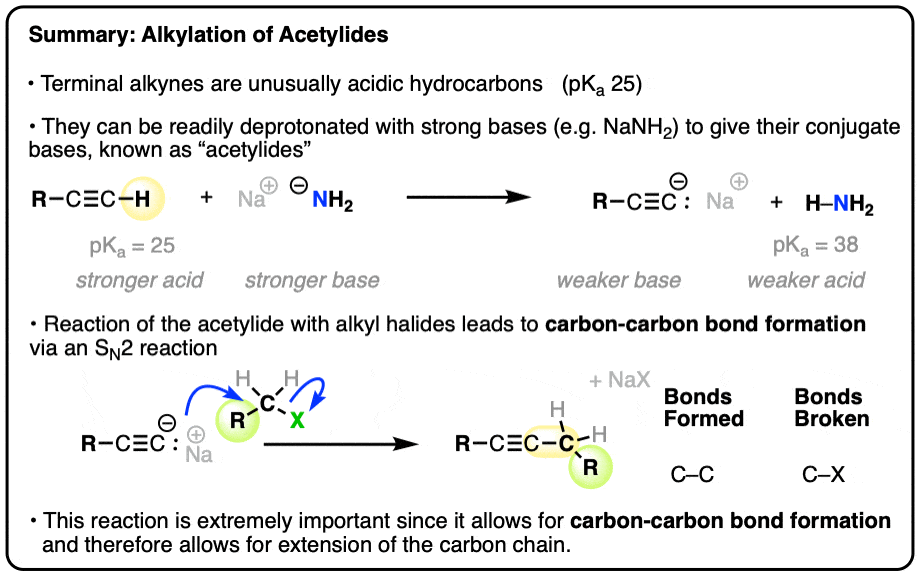
Table of Contents
-
- Terminal Alkynes Are Acidic!
- Alkylations of Acetylides With Primary Alkyl Halides: Finally, Some Carbon-Carbon Bond Formation!
- Alkylation of Acetylides – Some Practice Questions
- Synthesis of Substituted Acetylenes – Practice Questions
- Other Reactions of Acetylides – Epoxide Opening and Addition to Aldehydes/Ketones
- Summary
- Notes
- Quiz Yourself!
- (Advanced) References and Further Reading
1. Terminal Alkynes Are Acidic!
Among hydrocarbons, terminal alkynes have a very special property. Their C-H bonds are unusually acidic (pKa 25).
The alkyne C-H bond is sp-hybridized. When C-H is deprotonated, the resulting carbanion is held in an orbital with 50% s-character. Since s-orbitals are closer to the nucleus than p-orbitals, this means that the electrons experience greater stabilization from the positively charged nucleus than the conjugate bases of alkenes and alkanes.
Any factor which stabilizes a lone pair of electrons tends to reduce its basicity. (See article – Key Factors That Influence Acidity). In fact, just thinking of “basicity” as a synonym for “lone-pair instability” can get you pretty far in organic chemistry!
A common choice of base for deprotonating the C-H bond of acetylenes is sodium amide (NaNH2), often used in its conjugate base, liquid ammonia (NH3). NaNH2 can also be used to deprotonate the great-granddaddy of all alkynes, acetylene itself. [Note 1]
Note – don’t confuse NaNH2/NH3 [strong base!] with sodium in ammonia,Na/NH3 [reducing agent for triple bonds!] [Note 2]

Acid-base reactions spontaneously proceed in the direction that gives weaker acids from stronger acids. (I lovingly call this the “Principle Of Acid-Base Mediocrity” – See article: How To Use a pKa Table).
Since we are proceeding from a stronger acid (terminal alkyne, pKa 25) towards a weaker conjugate acid (NH3, pKa 38) the acid-base equilibrium here will be favorable.
On the other hand, the acid-base reaction between NaNH2 and alkenes (pKa 42) or alkanes (pKa 50) is unfavorable since it would result in a stronger acid (NH3, pKa 38), as well as a stronger base. Remember – the stronger the acid, the weaker the conjugate base!
2. SN2 Reactions of Acetylides With Alkyl Halides: Finally, Some Carbon-Carbon Bond Formation!
OK. So we can make acetylides. Now what?
Well, acetylides are excellent nucleophiles. They react with alkyl halides to give internal alkynes, in a reaction known as nucleophilic (aliphatic) substitution.
It is a substitution reaction because a new bond is formed (C-C) at the same carbon where a bond is broken (C-X, where X is a good leaving group). ( See article: What Makes a Good Leaving Group?).
More specifically, the substitution proceeds through an SN2 mechanism (substitution, nucleophilic, bimolecular rate-determining step) since the C–C bond is being formed at the same time that the C–X bond breaks. The reaction occurs via donation of the nucleophile lone pair into the sigma* orbital of the C-X bond, often referred to as a “backside attack”. It results in inversion of configuration at the carbon, although inversion can only be observed with carbons bearing a chiral center. (See article: The SN2 Mechanism)
The reaction works best for primary (and methyl) alkyl halides due to their lack of steric hindrance.

Secondary alkyl halides tend to give elimination (E2) instead of substitution, since there is more steric hindrance at a secondary carbon and acetylide is still a very strong base – even if it’s a weak base for a hydrocarbon!
All right. Perhaps you’ve already covered nucleophilic substitution reactions, and this reaction might not seem like such a big deal to you. Fair.
I would like to draw your attention, however, to the key bond that is formed in this reaction: C–C.
Up until this point, it’s unlikely you’ve covered any carbon-carbon bond forming reactions. If you’ve covered any at all, it might be the cyanide ion (e.g. NaCN) with alkyl halides. That isn’t so important for our purposes since we don’t cover reactions of cyano groups until later on in Org 2.
Since organic chemistry is ultimately the chemistry of carbon, having the ability to form a new C-C bond from a terminal alkyne via an SN2 reaction is huge because it allows us to plan the synthesis of essentially any linear hydrocarbon from acetylene, provided we can partner it with primary alkyl halide.
(Those primary alkyl halides can themselves be made from various reactions with acetylene, a point we’ll get to later in this chapter!).
The example below, for instance, shows the synthesis of 5-decyne:
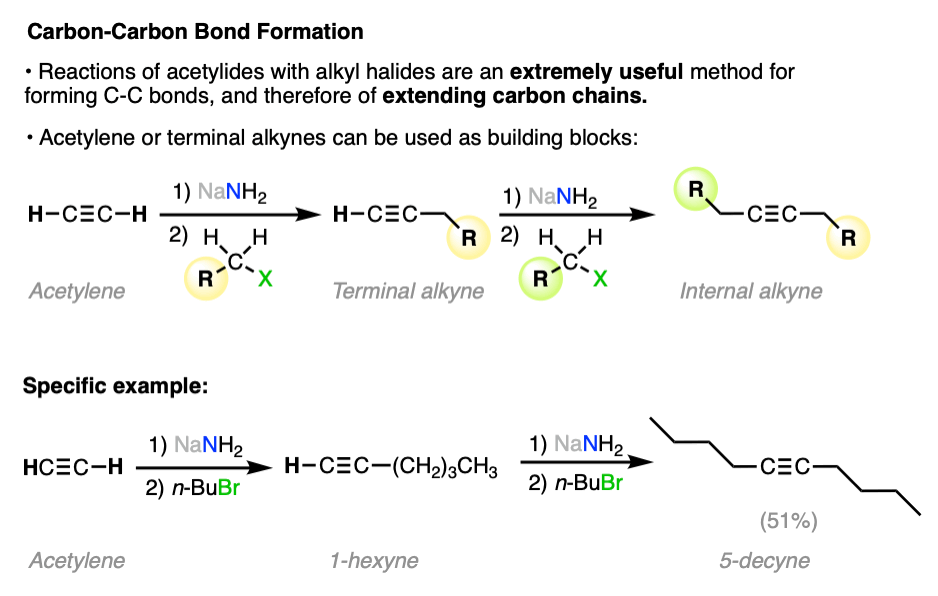
This reaction is extremely versatile. Simply by changing the identity of the alkyl halide, we can tack on pretty much any alkyl group we want – so long as it’s primary – which gives us access to a huge variety of linear hydrocarbons!
3. Alkylation of Acetylides – Some Practice Questions
We’ll get to some synthesis applications a little further below. In the meantime, see if you can draw the product of this reaction:
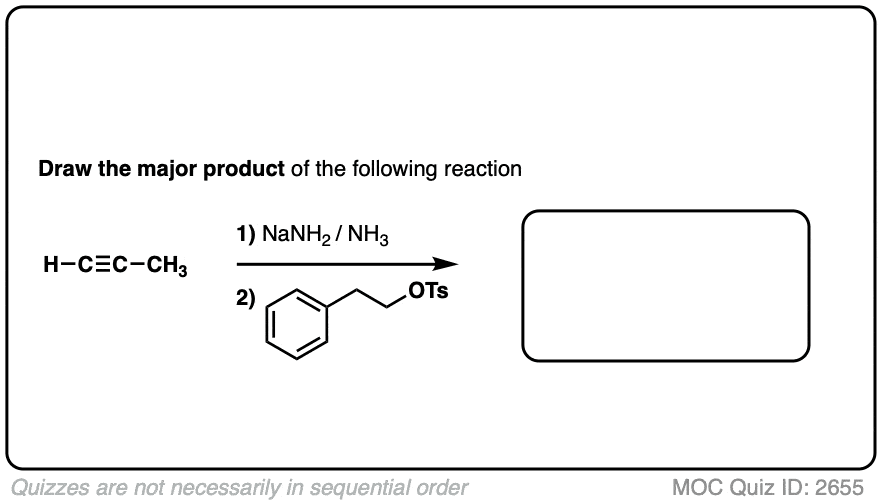 Click to Flip
Click to Flip
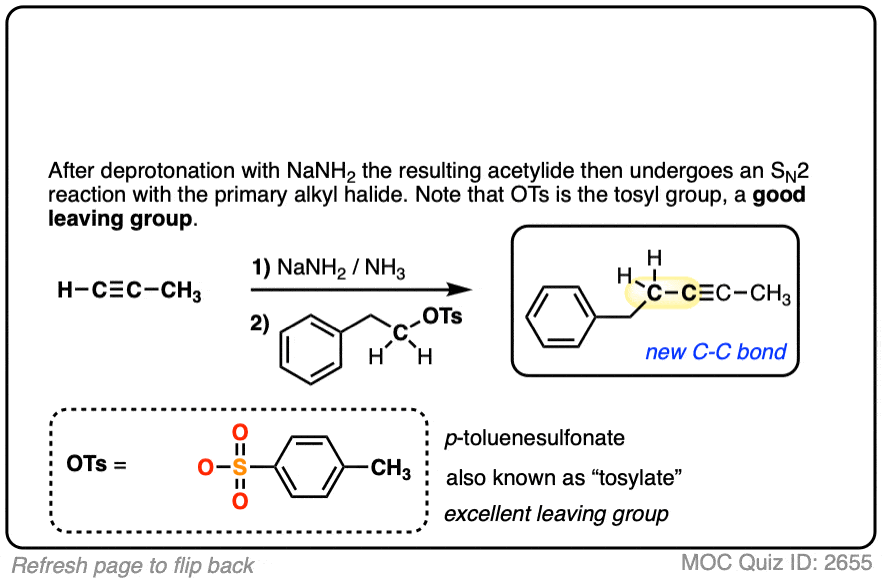
Here is another example of a reaction between an acetylide and an alkyl halide. Can you draw the product? (D is deuterium, the heavy isotope of hydrogen).
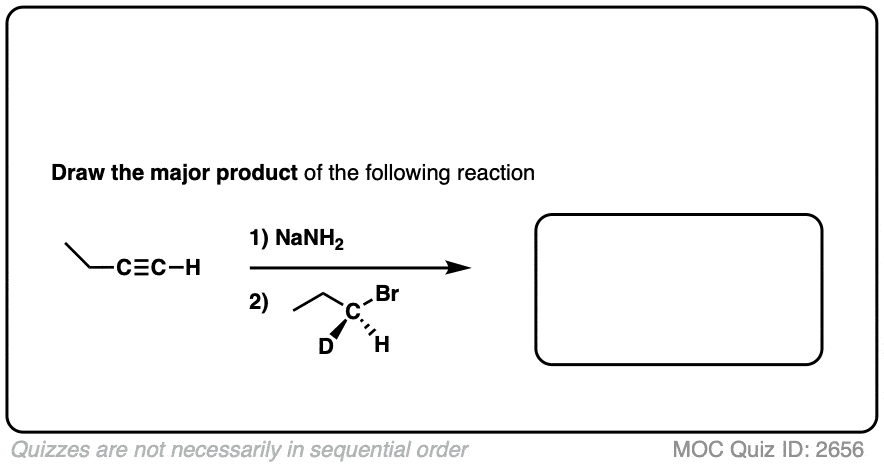 Click to Flip
Click to Flip
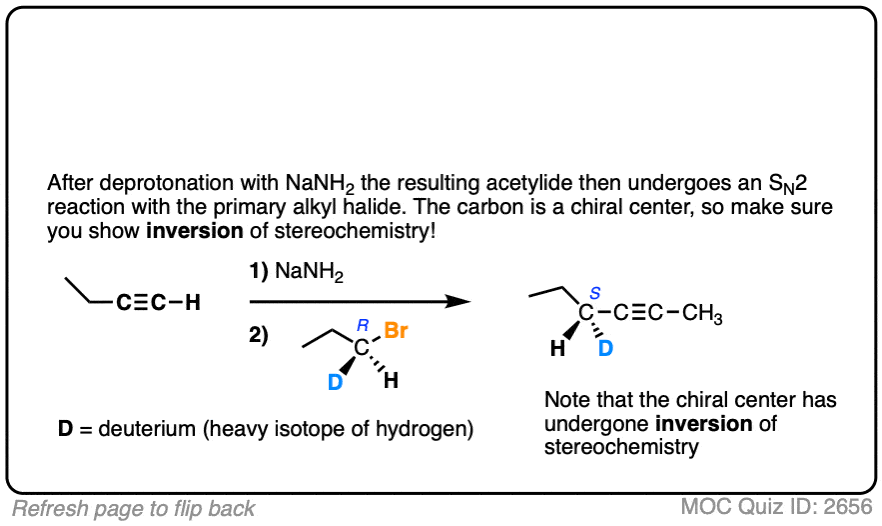
Draw the product of the reaction below:
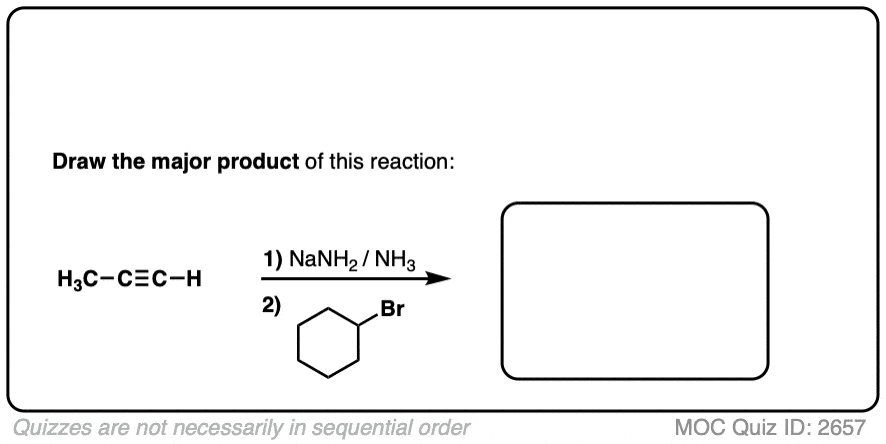 Click to Flip
Click to Flip
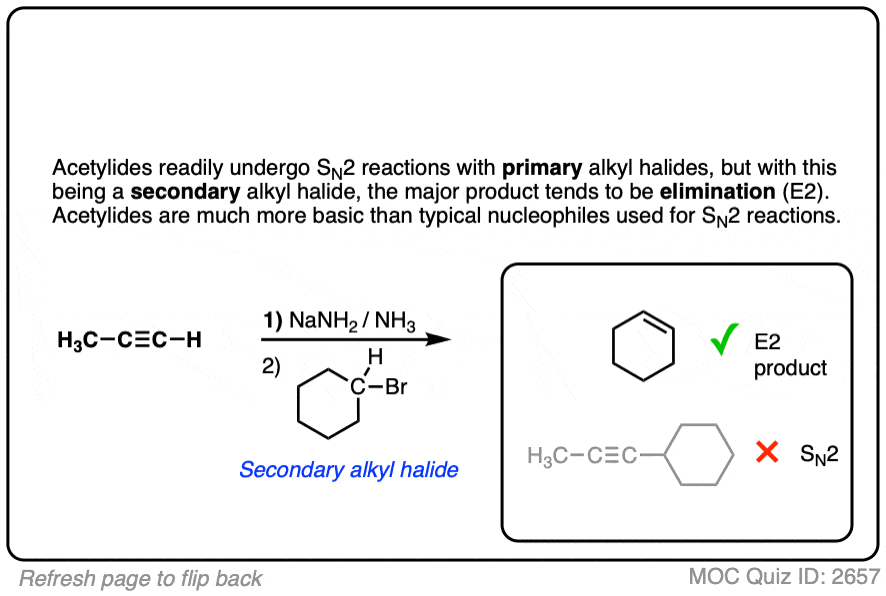
In the reaction below, the acetylide is treated with an alkyl halide containing two leaving groups. Draw the product!
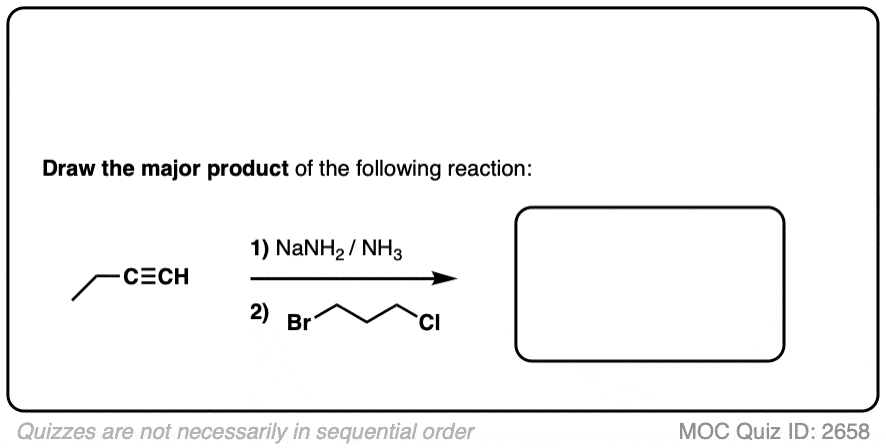 Click to Flip
Click to Flip

4. Practice Questions – Synthesis of Acetylenes
As mentioned above in section two, the SN2 reaction between acetylides and alkyl halides means that we can build up pretty much any linear alkyne from acetylene, provided that we have the necessary (linear) alkyl halides.
The questions below ask you to show how you would synthesize internal alkynes from acetylene and alkyl halides.
Here’s one synthesis problem:
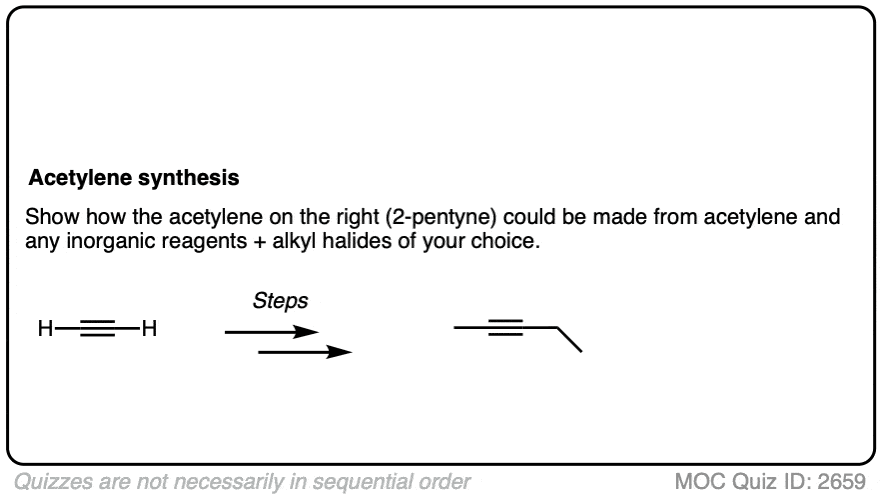 Click to Flip
Click to Flip

A second, slightly more difficult synthesis question.
 Click to Flip
Click to Flip
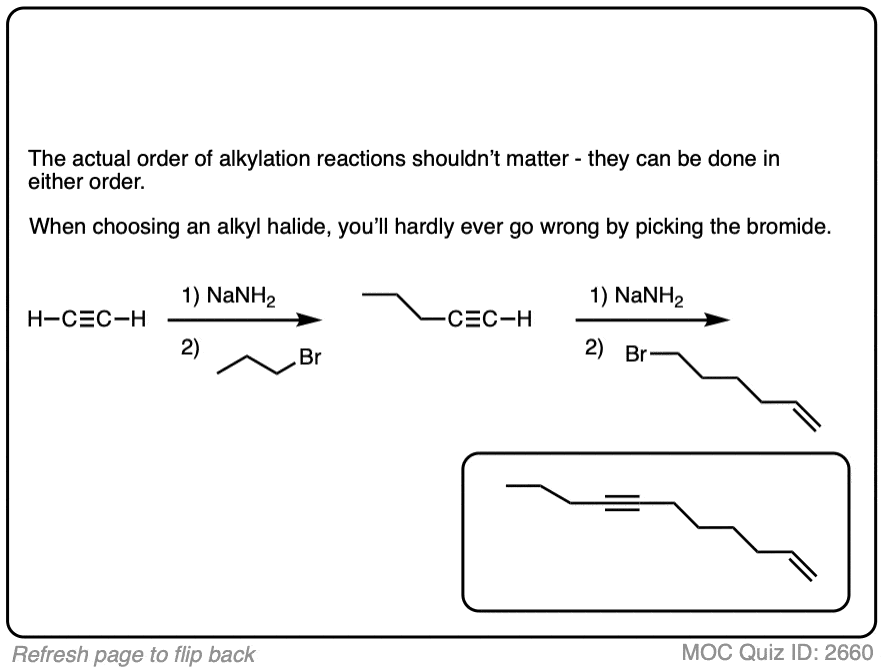
More of the same thing!
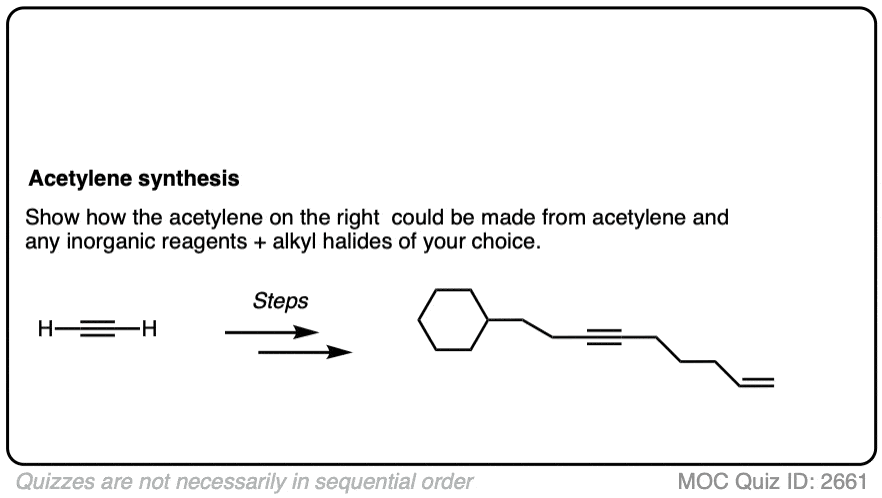 Click to Flip
Click to Flip
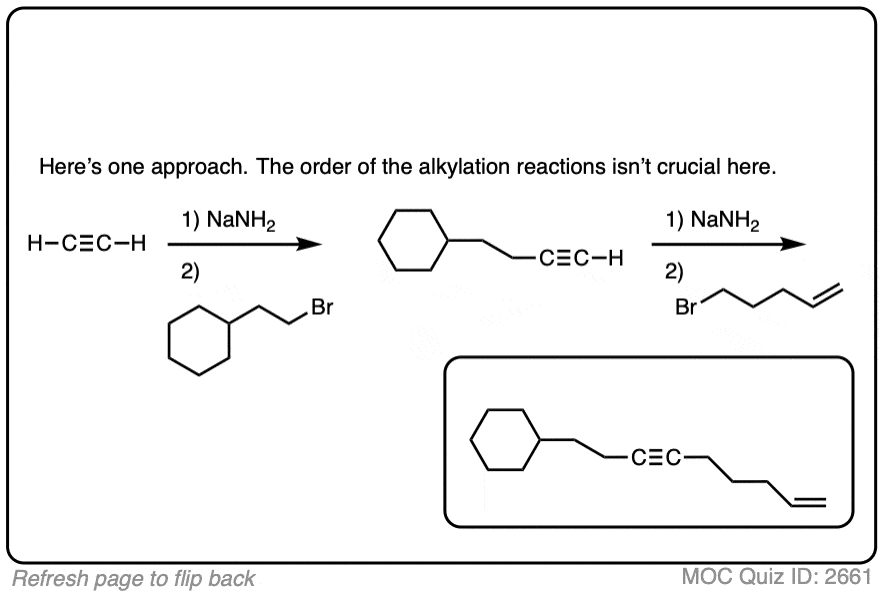
5. Reaction of Acetylides With Other Nucleophiles
Acetylides don’t just react with alkyl halides! They are versatile nucleophiles with other electrophiles as well, although you might not see some of these reactions until later in your course, or perhaps in the second semester of a two-semester course.
Epoxides are 3-membered cyclic ethers with considerable ring strain (about 13 kcal/mol) (See article – Epoxides, The Outlier of the Ether Family). Acetylides will react with epoxides at the least substituted position to form new C-C bonds (See Article: Epoxide Ring-Opening With Base)

Acetylides will also add to aldehydes and ketones through nucleophilic addition to the C-O pi bond. In this respect the reaction of acetylides is essentially identical to those of Grignard reagents.

6. Summary
- Acetylides react with primary and methyl alkyl halides to give new C-C bonds via nucleophilic substitution (SN2 mechanism).
- They tend to give elimination with secondary alkyl halides.
- This is an extremely important reaction for first semester organic chemistry, as it allows for formation of longer carbon chains from acetylene.
In the next article in this series, we will show how the triple bond of alkynes can be partially hydrogenated to give alkenes. (See article: Partial Hydrogenation of Alkynes to Give Alkenes)
Notes
Related Articles
- Partial Reduction of Alkynes With Lindlar’s Catalyst
- Partial Reduction of Alkynes With Na/NH3 To Obtain Trans Alkenes
- Alkyne Hydroboration With “R2BH”
- Five Key Factors That Influence Acidity
- The SN2 Mechanism
- 7 Factors that stabilize negative charge in organic chemistry
- Hybrid Orbitals and Hybridization
- Why the SN2 Reaction Is Powerful
- What Makes A Good Nucleophile?
- Alkynes Are A Blank Canvas
Note 1. Conditions for the deprotonation of acetylene are here. Note that acetylene is a gas, so it has to be bubbled through a solution containing NaNH2 in ammonia. These days, it’s more common just to just purchase the conjugate base of acetylene (such as lithium acetylide, diethylamine complex) directly from a commercial supplier like Aldrich and weigh it out.
Note 2. By no means is NaNH2 the only base used for deprotonating acetylenes, it just seems to be the textbook reagent of choice. Grignard and organolithium reagents are also often used to form acetylides.
Quiz Yourself!
[Quizzes]
(Advanced) References and Further Reading
This is a pretty standard acid-base reaction, driven by the acidity of the sp-H atom. The utility lies in that this is still a robust method of C-C bond formation, and a useful way to introduce alkynyl groups if desired.
- THE PREPARATION AND ALKYLATION OF METAL ACETYLIDES IN LIQUID AMMONIA*
T. H. Vaughn, G. F. Hennion, R. R. Vogt, and J. A. Nieuwland
The Journal of Organic Chemistry 1937 02 (1), 1-22
DOI: 10.1021/jo01224a001 - PREPARATION AND USE OF LITHIUM ACETYLIDE: 1-METHYL-2-ETHYNYL-endo-3,3-DIMETHYL-2-NORBORNANOL
Mark Midland, Jim I. McLoughlin, and Ralph T. Werley Jr
Org. Synth. 1990, 68, 14
DOI: 10.15227/orgsyn.068.0014
I was initially a little surprised that something like this was published so recently in Organic Syntheses, but reading the discussion gives some context. The selective formation of the monolithiated species from deprotonation of acetylene is tricky. - 1-PHENYL-1-PENTEN-4-YN-3-OL
Lars Skattebøl, E. R. H. Jones, and Mark C. Whiting
Org. Synth. 1959, 39, 56
DOI: 10.15227/orgsyn.039.0056
Alkynyl Grignards can also be formed by deprotonation of a terminal alkyne with a Grignard reagent, as this procedure demonstrates. - n-BUTYLACETYLENE
Kenneth N. Campbell and Barbara K. Campbell
Org. Synth. 1950 30, 15
DOI: 10.15227/orgsyn.030.0015
An extremely simple example of this reaction. The deprotonation is done with Na metal in liquid ammonia, and care has to be taken to avoid the conditions of dissolving metal reduction (the procedure states that the reaction should not turn blue) - Synthesis of Unsymmetrical Alkynes via the Alkylation of Sodium Acetylides. An Introduction to Synthetic Design for Organic Chemistry Students
Jennifer N. Shepherd and Jason R. Stenzel
Journal of Chemical Education 2006, 83 (3), 425
DOI: 10.1021/ed083p425
A nice paper that describes the adaptation of this reaction for undergraduate teaching labs.
00 General Chemistry Review
01 Bonding, Structure, and Resonance
- How Do We Know Methane (CH4) Is Tetrahedral?
- Hybrid Orbitals and Hybridization
- How To Determine Hybridization: A Shortcut
- Orbital Hybridization And Bond Strengths
- Sigma bonds come in six varieties: Pi bonds come in one
- A Key Skill: How to Calculate Formal Charge
- The Four Intermolecular Forces and How They Affect Boiling Points
- 3 Trends That Affect Boiling Points
- How To Use Electronegativity To Determine Electron Density (and why NOT to trust formal charge)
- Introduction to Resonance
- How To Use Curved Arrows To Interchange Resonance Forms
- Evaluating Resonance Forms (1) - The Rule of Least Charges
- How To Find The Best Resonance Structure By Applying Electronegativity
- Evaluating Resonance Structures With Negative Charges
- Evaluating Resonance Structures With Positive Charge
- Exploring Resonance: Pi-Donation
- Exploring Resonance: Pi-acceptors
- In Summary: Evaluating Resonance Structures
- Drawing Resonance Structures: 3 Common Mistakes To Avoid
- How to apply electronegativity and resonance to understand reactivity
- Bond Hybridization Practice
- Structure and Bonding Practice Quizzes
- Resonance Structures Practice
02 Acid Base Reactions
- Introduction to Acid-Base Reactions
- Acid Base Reactions In Organic Chemistry
- The Stronger The Acid, The Weaker The Conjugate Base
- Walkthrough of Acid-Base Reactions (3) - Acidity Trends
- Five Key Factors That Influence Acidity
- Acid-Base Reactions: Introducing Ka and pKa
- How to Use a pKa Table
- The pKa Table Is Your Friend
- A Handy Rule of Thumb for Acid-Base Reactions
- Acid Base Reactions Are Fast
- pKa Values Span 60 Orders Of Magnitude
- How Protonation and Deprotonation Affect Reactivity
- Acid Base Practice Problems
03 Alkanes and Nomenclature
- Meet the (Most Important) Functional Groups
- Condensed Formulas: Deciphering What the Brackets Mean
- Hidden Hydrogens, Hidden Lone Pairs, Hidden Counterions
- Don't Be Futyl, Learn The Butyls
- Primary, Secondary, Tertiary, Quaternary In Organic Chemistry
- Branching, and Its Affect On Melting and Boiling Points
- The Many, Many Ways of Drawing Butane
- Wedge And Dash Convention For Tetrahedral Carbon
- Common Mistakes in Organic Chemistry: Pentavalent Carbon
- Table of Functional Group Priorities for Nomenclature
- Summary Sheet - Alkane Nomenclature
- Organic Chemistry IUPAC Nomenclature Demystified With A Simple Puzzle Piece Approach
- Boiling Point Quizzes
- Organic Chemistry Nomenclature Quizzes
04 Conformations and Cycloalkanes
- Staggered vs Eclipsed Conformations of Ethane
- Conformational Isomers of Propane
- Newman Projection of Butane (and Gauche Conformation)
- Introduction to Cycloalkanes (1)
- Geometric Isomers In Small Rings: Cis And Trans Cycloalkanes
- Calculation of Ring Strain In Cycloalkanes
- Cycloalkanes - Ring Strain In Cyclopropane And Cyclobutane
- Cyclohexane Conformations
- Cyclohexane Chair Conformation: An Aerial Tour
- How To Draw The Cyclohexane Chair Conformation
- The Cyclohexane Chair Flip
- The Cyclohexane Chair Flip - Energy Diagram
- Substituted Cyclohexanes - Axial vs Equatorial
- Ranking The Bulkiness Of Substituents On Cyclohexanes: "A-Values"
- Cyclohexane Chair Conformation Stability: Which One Is Lower Energy?
- Fused Rings - Cis-Decalin and Trans-Decalin
- Naming Bicyclic Compounds - Fused, Bridged, and Spiro
- Bredt's Rule (And Summary of Cycloalkanes)
- Newman Projection Practice
- Cycloalkanes Practice Problems
05 A Primer On Organic Reactions
- The Most Important Question To Ask When Learning a New Reaction
- Learning New Reactions: How Do The Electrons Move?
- The Third Most Important Question to Ask When Learning A New Reaction
- 7 Factors that stabilize negative charge in organic chemistry
- 7 Factors That Stabilize Positive Charge in Organic Chemistry
- Nucleophiles and Electrophiles
- Curved Arrows (for reactions)
- Curved Arrows (2): Initial Tails and Final Heads
- Nucleophilicity vs. Basicity
- The Three Classes of Nucleophiles
- What Makes A Good Nucleophile?
- What makes a good leaving group?
- 3 Factors That Stabilize Carbocations
- Equilibrium and Energy Relationships
- What's a Transition State?
- Hammond's Postulate
- Learning Organic Chemistry Reactions: A Checklist (PDF)
- Introduction to Free Radical Substitution Reactions
- Introduction to Oxidative Cleavage Reactions
06 Free Radical Reactions
- Bond Dissociation Energies = Homolytic Cleavage
- Free Radical Reactions
- 3 Factors That Stabilize Free Radicals
- What Factors Destabilize Free Radicals?
- Bond Strengths And Radical Stability
- Free Radical Initiation: Why Is "Light" Or "Heat" Required?
- Initiation, Propagation, Termination
- Monochlorination Products Of Propane, Pentane, And Other Alkanes
- Selectivity In Free Radical Reactions
- Selectivity in Free Radical Reactions: Bromination vs. Chlorination
- Halogenation At Tiffany's
- Allylic Bromination
- Bonus Topic: Allylic Rearrangements
- In Summary: Free Radicals
- Synthesis (2) - Reactions of Alkanes
- Free Radicals Practice Quizzes
07 Stereochemistry and Chirality
- Types of Isomers: Constitutional Isomers, Stereoisomers, Enantiomers, and Diastereomers
- How To Draw The Enantiomer Of A Chiral Molecule
- How To Draw A Bond Rotation
- Introduction to Assigning (R) and (S): The Cahn-Ingold-Prelog Rules
- Assigning Cahn-Ingold-Prelog (CIP) Priorities (2) - The Method of Dots
- Enantiomers vs Diastereomers vs The Same? Two Methods For Solving Problems
- Assigning R/S To Newman Projections (And Converting Newman To Line Diagrams)
- How To Determine R and S Configurations On A Fischer Projection
- The Meso Trap
- Optical Rotation, Optical Activity, and Specific Rotation
- Optical Purity and Enantiomeric Excess
- What's a Racemic Mixture?
- Chiral Allenes And Chiral Axes
- Stereochemistry Practice Problems and Quizzes
08 Substitution Reactions
- Introduction to Nucleophilic Substitution Reactions
- Walkthrough of Substitution Reactions (1) - Introduction
- Two Types of Nucleophilic Substitution Reactions
- The SN2 Mechanism
- Why the SN2 Reaction Is Powerful
- The SN1 Mechanism
- The Conjugate Acid Is A Better Leaving Group
- Comparing the SN1 and SN2 Reactions
- Polar Protic? Polar Aprotic? Nonpolar? All About Solvents
- Steric Hindrance is Like a Fat Goalie
- Common Blind Spot: Intramolecular Reactions
- The Conjugate Base is Always a Stronger Nucleophile
- Substitution Practice - SN1
- Substitution Practice - SN2
09 Elimination Reactions
- Elimination Reactions (1): Introduction And The Key Pattern
- Elimination Reactions (2): The Zaitsev Rule
- Elimination Reactions Are Favored By Heat
- Two Elimination Reaction Patterns
- The E1 Reaction
- The E2 Mechanism
- E1 vs E2: Comparing the E1 and E2 Reactions
- Antiperiplanar Relationships: The E2 Reaction and Cyclohexane Rings
- Bulky Bases in Elimination Reactions
- Comparing the E1 vs SN1 Reactions
- Elimination (E1) Reactions With Rearrangements
- E1cB - Elimination (Unimolecular) Conjugate Base
- Elimination (E1) Practice Problems And Solutions
- Elimination (E2) Practice Problems and Solutions
10 Rearrangements
11 SN1/SN2/E1/E2 Decision
- Identifying Where Substitution and Elimination Reactions Happen
- Deciding SN1/SN2/E1/E2 (1) - The Substrate
- Deciding SN1/SN2/E1/E2 (2) - The Nucleophile/Base
- SN1 vs E1 and SN2 vs E2 : The Temperature
- Deciding SN1/SN2/E1/E2 - The Solvent
- Wrapup: The Key Factors For Determining SN1/SN2/E1/E2
- Alkyl Halide Reaction Map And Summary
- SN1 SN2 E1 E2 Practice Problems
12 Alkene Reactions
- E and Z Notation For Alkenes (+ Cis/Trans)
- Alkene Stability
- Alkene Addition Reactions: "Regioselectivity" and "Stereoselectivity" (Syn/Anti)
- Stereoselective and Stereospecific Reactions
- Hydrohalogenation of Alkenes and Markovnikov's Rule
- Hydration of Alkenes With Aqueous Acid
- Rearrangements in Alkene Addition Reactions
- Halogenation of Alkenes and Halohydrin Formation
- Oxymercuration Demercuration of Alkenes
- Hydroboration Oxidation of Alkenes
- m-CPBA (meta-chloroperoxybenzoic acid)
- OsO4 (Osmium Tetroxide) for Dihydroxylation of Alkenes
- Palladium on Carbon (Pd/C) for Catalytic Hydrogenation of Alkenes
- Cyclopropanation of Alkenes
- A Fourth Alkene Addition Pattern - Free Radical Addition
- Alkene Reactions: Ozonolysis
- Summary: Three Key Families Of Alkene Reaction Mechanisms
- Synthesis (4) - Alkene Reaction Map, Including Alkyl Halide Reactions
- Alkene Reactions Practice Problems
13 Alkyne Reactions
- Acetylides from Alkynes, And Substitution Reactions of Acetylides
- Partial Reduction of Alkynes With Lindlar's Catalyst
- Partial Reduction of Alkynes With Na/NH3 To Obtain Trans Alkenes
- Alkyne Hydroboration With "R2BH"
- Hydration and Oxymercuration of Alkynes
- Hydrohalogenation of Alkynes
- Alkyne Halogenation: Bromination, Chlorination, and Iodination of Alkynes
- Alkyne Reactions - The "Concerted" Pathway
- Alkenes To Alkynes Via Halogenation And Elimination Reactions
- Alkynes Are A Blank Canvas
- Synthesis (5) - Reactions of Alkynes
- Alkyne Reactions Practice Problems With Answers
14 Alcohols, Epoxides and Ethers
- Alcohols - Nomenclature and Properties
- Alcohols Can Act As Acids Or Bases (And Why It Matters)
- Alcohols - Acidity and Basicity
- The Williamson Ether Synthesis
- Ethers From Alkenes, Tertiary Alkyl Halides and Alkoxymercuration
- Alcohols To Ethers via Acid Catalysis
- Cleavage Of Ethers With Acid
- Epoxides - The Outlier Of The Ether Family
- Opening of Epoxides With Acid
- Epoxide Ring Opening With Base
- Making Alkyl Halides From Alcohols
- Tosylates And Mesylates
- PBr3 and SOCl2
- Elimination Reactions of Alcohols
- Elimination of Alcohols To Alkenes With POCl3
- Alcohol Oxidation: "Strong" and "Weak" Oxidants
- Demystifying The Mechanisms of Alcohol Oxidations
- Protecting Groups For Alcohols
- Thiols And Thioethers
- Calculating the oxidation state of a carbon
- Oxidation and Reduction in Organic Chemistry
- Oxidation Ladders
- SOCl2 Mechanism For Alcohols To Alkyl Halides: SN2 versus SNi
- Alcohol Reactions Roadmap (PDF)
- Alcohol Reaction Practice Problems
- Epoxide Reaction Quizzes
- Oxidation and Reduction Practice Quizzes
15 Organometallics
- What's An Organometallic?
- Formation of Grignard and Organolithium Reagents
- Organometallics Are Strong Bases
- Reactions of Grignard Reagents
- Protecting Groups In Grignard Reactions
- Synthesis Problems Involving Grignard Reagents
- Grignard Reactions And Synthesis (2)
- Organocuprates (Gilman Reagents): How They're Made
- Gilman Reagents (Organocuprates): What They're Used For
- The Heck, Suzuki, and Olefin Metathesis Reactions (And Why They Don't Belong In Most Introductory Organic Chemistry Courses)
- Reaction Map: Reactions of Organometallics
- Grignard Practice Problems
16 Spectroscopy
- Degrees of Unsaturation (or IHD, Index of Hydrogen Deficiency)
- Conjugation And Color (+ How Bleach Works)
- Introduction To UV-Vis Spectroscopy
- UV-Vis Spectroscopy: Absorbance of Carbonyls
- UV-Vis Spectroscopy: Practice Questions
- Bond Vibrations, Infrared Spectroscopy, and the "Ball and Spring" Model
- Infrared Spectroscopy: A Quick Primer On Interpreting Spectra
- IR Spectroscopy: 4 Practice Problems
- 1H NMR: How Many Signals?
- Homotopic, Enantiotopic, Diastereotopic
- Diastereotopic Protons in 1H NMR Spectroscopy: Examples
- C13 NMR - How Many Signals
- Liquid Gold: Pheromones In Doe Urine
- Natural Product Isolation (1) - Extraction
- Natural Product Isolation (2) - Purification Techniques, An Overview
- Structure Determination Case Study: Deer Tarsal Gland Pheromone
17 Dienes and MO Theory
- What To Expect In Organic Chemistry 2
- Are these molecules conjugated?
- Conjugation And Resonance In Organic Chemistry
- Bonding And Antibonding Pi Orbitals
- Molecular Orbitals of The Allyl Cation, Allyl Radical, and Allyl Anion
- Pi Molecular Orbitals of Butadiene
- Reactions of Dienes: 1,2 and 1,4 Addition
- Thermodynamic and Kinetic Products
- More On 1,2 and 1,4 Additions To Dienes
- s-cis and s-trans
- The Diels-Alder Reaction
- Cyclic Dienes and Dienophiles in the Diels-Alder Reaction
- Stereochemistry of the Diels-Alder Reaction
- Exo vs Endo Products In The Diels Alder: How To Tell Them Apart
- HOMO and LUMO In the Diels Alder Reaction
- Why Are Endo vs Exo Products Favored in the Diels-Alder Reaction?
- Diels-Alder Reaction: Kinetic and Thermodynamic Control
- The Retro Diels-Alder Reaction
- The Intramolecular Diels Alder Reaction
- Regiochemistry In The Diels-Alder Reaction
- The Cope and Claisen Rearrangements
- Electrocyclic Reactions
- Electrocyclic Ring Opening And Closure (2) - Six (or Eight) Pi Electrons
- Diels Alder Practice Problems
- Molecular Orbital Theory Practice
18 Aromaticity
- Introduction To Aromaticity
- Rules For Aromaticity
- Huckel's Rule: What Does 4n+2 Mean?
- Aromatic, Non-Aromatic, or Antiaromatic? Some Practice Problems
- Antiaromatic Compounds and Antiaromaticity
- The Pi Molecular Orbitals of Benzene
- The Pi Molecular Orbitals of Cyclobutadiene
- Frost Circles
- Aromaticity Practice Quizzes
19 Reactions of Aromatic Molecules
- Electrophilic Aromatic Substitution: Introduction
- Activating and Deactivating Groups In Electrophilic Aromatic Substitution
- Electrophilic Aromatic Substitution - The Mechanism
- Ortho-, Para- and Meta- Directors in Electrophilic Aromatic Substitution
- Understanding Ortho, Para, and Meta Directors
- Why are halogens ortho- para- directors?
- Disubstituted Benzenes: The Strongest Electron-Donor "Wins"
- Electrophilic Aromatic Substitutions (1) - Halogenation of Benzene
- Electrophilic Aromatic Substitutions (2) - Nitration and Sulfonation
- EAS Reactions (3) - Friedel-Crafts Acylation and Friedel-Crafts Alkylation
- Intramolecular Friedel-Crafts Reactions
- Nucleophilic Aromatic Substitution (NAS)
- Nucleophilic Aromatic Substitution (2) - The Benzyne Mechanism
- Reactions on the "Benzylic" Carbon: Bromination And Oxidation
- The Wolff-Kishner, Clemmensen, And Other Carbonyl Reductions
- More Reactions on the Aromatic Sidechain: Reduction of Nitro Groups and the Baeyer Villiger
- Aromatic Synthesis (1) - "Order Of Operations"
- Synthesis of Benzene Derivatives (2) - Polarity Reversal
- Aromatic Synthesis (3) - Sulfonyl Blocking Groups
- Birch Reduction
- Synthesis (7): Reaction Map of Benzene and Related Aromatic Compounds
- Aromatic Reactions and Synthesis Practice
- Electrophilic Aromatic Substitution Practice Problems
20 Aldehydes and Ketones
- What's The Alpha Carbon In Carbonyl Compounds?
- Nucleophilic Addition To Carbonyls
- Aldehydes and Ketones: 14 Reactions With The Same Mechanism
- Sodium Borohydride (NaBH4) Reduction of Aldehydes and Ketones
- Grignard Reagents For Addition To Aldehydes and Ketones
- Wittig Reaction
- Hydrates, Hemiacetals, and Acetals
- Imines - Properties, Formation, Reactions, and Mechanisms
- All About Enamines
- Breaking Down Carbonyl Reaction Mechanisms: Reactions of Anionic Nucleophiles (Part 2)
- Aldehydes Ketones Reaction Practice
21 Carboxylic Acid Derivatives
- Nucleophilic Acyl Substitution (With Negatively Charged Nucleophiles)
- Addition-Elimination Mechanisms With Neutral Nucleophiles (Including Acid Catalysis)
- Basic Hydrolysis of Esters - Saponification
- Transesterification
- Proton Transfer
- Fischer Esterification - Carboxylic Acid to Ester Under Acidic Conditions
- Lithium Aluminum Hydride (LiAlH4) For Reduction of Carboxylic Acid Derivatives
- LiAlH[Ot-Bu]3 For The Reduction of Acid Halides To Aldehydes
- Di-isobutyl Aluminum Hydride (DIBAL) For The Partial Reduction of Esters and Nitriles
- Amide Hydrolysis
- Thionyl Chloride (SOCl2)
- Diazomethane (CH2N2)
- Carbonyl Chemistry: Learn Six Mechanisms For the Price Of One
- Making Music With Mechanisms (PADPED)
- Carboxylic Acid Derivatives Practice Questions
22 Enols and Enolates
- Keto-Enol Tautomerism
- Enolates - Formation, Stability, and Simple Reactions
- Kinetic Versus Thermodynamic Enolates
- Aldol Addition and Condensation Reactions
- Reactions of Enols - Acid-Catalyzed Aldol, Halogenation, and Mannich Reactions
- Claisen Condensation and Dieckmann Condensation
- Decarboxylation
- The Malonic Ester and Acetoacetic Ester Synthesis
- The Michael Addition Reaction and Conjugate Addition
- The Robinson Annulation
- Haloform Reaction
- The Hell–Volhard–Zelinsky Reaction
- Enols and Enolates Practice Quizzes
23 Amines
- The Amide Functional Group: Properties, Synthesis, and Nomenclature
- Basicity of Amines And pKaH
- 5 Key Basicity Trends of Amines
- The Mesomeric Effect And Aromatic Amines
- Nucleophilicity of Amines
- Alkylation of Amines (Sucks!)
- Reductive Amination
- The Gabriel Synthesis
- Some Reactions of Azides
- The Hofmann Elimination
- The Hofmann and Curtius Rearrangements
- The Cope Elimination
- Protecting Groups for Amines - Carbamates
- The Strecker Synthesis of Amino Acids
- Introduction to Peptide Synthesis
- Reactions of Diazonium Salts: Sandmeyer and Related Reactions
- Amine Practice Questions
24 Carbohydrates
- D and L Notation For Sugars
- Pyranoses and Furanoses: Ring-Chain Tautomerism In Sugars
- What is Mutarotation?
- Reducing Sugars
- The Big Damn Post Of Carbohydrate-Related Chemistry Definitions
- The Haworth Projection
- Converting a Fischer Projection To A Haworth (And Vice Versa)
- Reactions of Sugars: Glycosylation and Protection
- The Ruff Degradation and Kiliani-Fischer Synthesis
- Isoelectric Points of Amino Acids (and How To Calculate Them)
- Carbohydrates Practice
- Amino Acid Quizzes
25 Fun and Miscellaneous
- A Gallery of Some Interesting Molecules From Nature
- Screw Organic Chemistry, I'm Just Going To Write About Cats
- On Cats, Part 1: Conformations and Configurations
- On Cats, Part 2: Cat Line Diagrams
- On Cats, Part 4: Enantiocats
- On Cats, Part 6: Stereocenters
- Organic Chemistry Is Shit
- The Organic Chemistry Behind "The Pill"
- Maybe they should call them, "Formal Wins" ?
- Why Do Organic Chemists Use Kilocalories?
- The Principle of Least Effort
- Organic Chemistry GIFS - Resonance Forms
- Reproducibility In Organic Chemistry
- What Holds The Nucleus Together?
- How Reactions Are Like Music
- Organic Chemistry and the New MCAT
26 Organic Chemistry Tips and Tricks
- Common Mistakes: Formal Charges Can Mislead
- Partial Charges Give Clues About Electron Flow
- Draw The Ugly Version First
- Organic Chemistry Study Tips: Learn the Trends
- The 8 Types of Arrows In Organic Chemistry, Explained
- Top 10 Skills To Master Before An Organic Chemistry 2 Final
- Common Mistakes with Carbonyls: Carboxylic Acids... Are Acids!
- Planning Organic Synthesis With "Reaction Maps"
- Alkene Addition Pattern #1: The "Carbocation Pathway"
- Alkene Addition Pattern #2: The "Three-Membered Ring" Pathway
- Alkene Addition Pattern #3: The "Concerted" Pathway
- Number Your Carbons!
- The 4 Major Classes of Reactions in Org 1
- How (and why) electrons flow
- Grossman's Rule
- Three Exam Tips
- A 3-Step Method For Thinking Through Synthesis Problems
- Putting It Together
- Putting Diels-Alder Products in Perspective
- The Ups and Downs of Cyclohexanes
- The Most Annoying Exceptions in Org 1 (Part 1)
- The Most Annoying Exceptions in Org 1 (Part 2)
- The Marriage May Be Bad, But the Divorce Still Costs Money
- 9 Nomenclature Conventions To Know
- Nucleophile attacks Electrophile
27 Case Studies of Successful O-Chem Students
- Success Stories: How Corina Got The The "Hard" Professor - And Got An A+ Anyway
- How Helena Aced Organic Chemistry
- From a "Drop" To B+ in Org 2 – How A Hard Working Student Turned It Around
- How Serge Aced Organic Chemistry
- Success Stories: How Zach Aced Organic Chemistry 1
- Success Stories: How Kari Went From C– to B+
- How Esther Bounced Back From a "C" To Get A's In Organic Chemistry 1 And 2
- How Tyrell Got The Highest Grade In Her Organic Chemistry Course
- This Is Why Students Use Flashcards
- Success Stories: How Stu Aced Organic Chemistry
- How John Pulled Up His Organic Chemistry Exam Grades
- Success Stories: How Nathan Aced Organic Chemistry (Without It Taking Over His Life)
- How Chris Aced Org 1 and Org 2
- Interview: How Jay Got an A+ In Organic Chemistry
- How to Do Well in Organic Chemistry: One Student's Advice
- "America's Top TA" Shares His Secrets For Teaching O-Chem
- "Organic Chemistry Is Like..." - A Few Metaphors
- How To Do Well In Organic Chemistry: Advice From A Tutor
- Guest post: "I went from being afraid of tests to actually looking forward to them".
Can you prepare 3_chloro_4_methyl_2_hexyne from butyne In this way
Sir, I have read that sikver acetyllide and copper acetylide reacts with mineral acids to form alkynes whereas sodium acetylide donot ,why is that?
Where have you read this? Acetylides will all be protonated by mineral acids.
The solvent protic and a-protic also effect the product as in case protic we ll have more elimination pdt while in a-protic we ll get substitution products.
what is the best way to workout these reactions to get pure pdt?
Protic solvents (pka about 14-18) are incompatible with acetylides (pKa about 25).
If we use tertiary alkylhalide,what will be the price the
Does it follow substitution or elimination?
Elimination. Acetylides are very strong bases and SN2 reactions don’t happen at tertiary centers.
When we react Acetylide Ion with Alkyl Halides, do we also get Elimination (minor) products ?
yep, minor products do form but are essentially broken down or reacted to form further compounds
Kumar, you only get elimination as the major product if you are reacting the acetylide ion with second and third degree alkyl halides.
Yes, exactly Lorik. Thank you